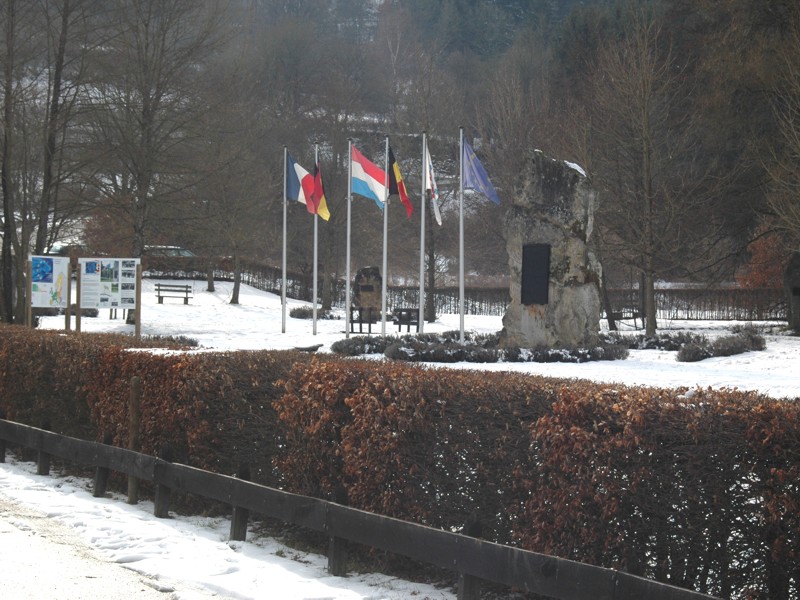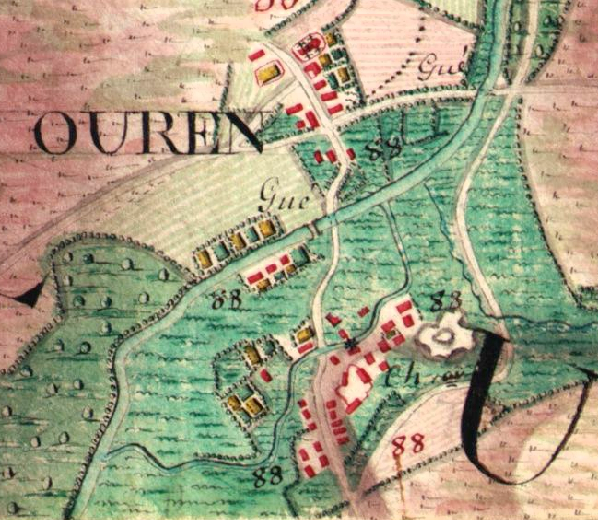|
Ouren
Ouren is a village in Belgium with a population of 129 inhabitants. Ouren is a part of the municipality of Burg-Reuland and thus belongs to the German-speaking Community of Belgium. Geography Ouren is located at the Tripoint, border triangle of Belgium-Germany-Luxembourg. All of the borders are tangent in the middle of the river Our River, Our. History Ouren Castle was founded approximately during the 11th or 12th century. For the first time it was mentioned in 1095 in connection with one of the lords of Ouren, Rycardis de Hunrin. It is assumed that at this point, Ouren Castle has already existed. In 1365 the Castle was merged into the ownership of the family of Malberg by marriage of William von Malberg with Elizabeth von Ouren. Shortly after, Castle Ouren was pledged to the Roman Catholic Diocese of Trier, archbishop of Treves. During the events of a feud between the archbishop Werner von Falkenstein and Eberhard II von der Mark, Eberhard von der Marck-Arenberg the fortification ... [...More Info...] [...Related Items...] OR: [Wikipedia] [Google] [Baidu] |
Ouren Castle
Ouren Castle is a Ruins, castle ruin in Ouren in the Eupen-Malmedy, East Cantons of Belgium. It was the ancestral seat of the lineage of the Edelfrei, free nobles of Ouren. Dating back to the 11th century, the site was originally a segmented, fortified castle fortress with a palas, a bergfried and a chapel in the higher-located northern part of the castle hill. The outer bailey with the service buildings were situated in the southern area. During the Late Middle Ages the castle gradually lost its fortified character in favour of the living comfort of its noble inhabitants. Between 1535 and 1615, periods of modification mark the changes to the residence of the nobility. A re-drawing in the lost watercolour by Joseph-Ernest Buschmann (1814-1853) from the mid-19th century shows the site as a – probably romanticized – Baroque castle. After its demolishment by French Revolutionary troops in 1794 the castle became uninhabitable and was nearly fully demolished after 1845. Locatio ... [...More Info...] [...Related Items...] OR: [Wikipedia] [Google] [Baidu] |
Our River
The Our (; , ) is a river in Belgium, Luxembourg and Germany. It is a left-hand tributary of the river Sauer, Sauer/Sûre. Its total length is . The source of the Our is in the High Fens in southeastern Belgium, near Büllingen, Manderfeld. It flows southwards, more or less along the German-Belgian border, and after Ouren, along the German-Luxembourg border. The historic town of Vianden lies on the Our. The Our empties into the Sauer (river), Sauer in Wallendorf (Eifel), Wallendorf. Course The river rises in the eastern Ardennes and western Eifel on Belgium, Belgian soil. Its source near the village of Losheimergraben lies northeast of the ''Eichelsberg'' mountain (653 m) at 643 m near the Bundesstraße 265, B 265. Just a few hundred metres away is the source of the River Kyll. The Our initially follows the B 265, which is also the Belgian-German state border. The river continues alternating between Belgium and Germany. From the tripoint by the Europa Monument betwe ... [...More Info...] [...Related Items...] OR: [Wikipedia] [Google] [Baidu] |
Burg-Reuland
Burg-Reuland () is a Municipalities of Belgium, municipality located in the Belgium, Belgian province of Liège (province), Liège. The name of the municipality refers to the Reuland Castle, castle "Burg-Reuland", which is located in the center of the community. On January 1, 2006, Burg-Reuland had a total population of 3,903. The total area is 108.96 km2 which gives a population density of 36 inhabitants per km2. Burg-Reuland is one of the municipalities of the German-speaking Community of Belgium. The municipality consists of the following deelgemeente, sub-municipalities: Reuland and Thommen, Belgium, Thommen. The point where Belgium, Germany and Luxembourg meet is located on the river Our River, Our, near the village of Ouren in this municipality. Sports Burg-Reuland has two main football clubs: SG Rapid Oudler of Oudler village (matricule number 7432), who play in the Belgian Provincial Leagues, Liège Provincial Leagues, and Racing Club Burg-Reuland, who play in loc ... [...More Info...] [...Related Items...] OR: [Wikipedia] [Google] [Baidu] |
Eupen
Eupen (, , ; ; ; former ) is the capital of German-speaking Community of Belgium and is a city and municipalities of Belgium, municipality in the Belgium, Belgian Liège Province, province of Liège, from the Germany, German border (Aachen), from the Netherlands, Dutch border (Maastricht) and from the "High Fens" nature reserve (Ardennes). The town is also the capital of the Euroregion Meuse-Rhine Euroregion, Meuse-Rhine. First mentioned in 1213 as belonging to the Duchy of Limburg, possession of Eupen passed to Brabant (duchy), Brabant, Burgundy (historical region), Burgundy, the Holy Roman Empire and France before being given in 1815 to Prussia, which became part of the new German Empire in 1871. In 1919, after the First World War, the Treaty of Versailles transferred Eupen and the nearby municipality of Malmedy from Germany to Belgium. German language, German remains the official language in Eupen (also spoken in the form of the Eupen dialect), and the city serves as th ... [...More Info...] [...Related Items...] OR: [Wikipedia] [Google] [Baidu] |
Malmedy
Malmedy (; , historically also ; ) is a city and municipality of Wallonia located in the province of Liège, Belgium. On January 1, 2018, Malmedy had a total population of 12,654. The total area is 99.96 km2 which gives a population density of 127 inhabitants per km2. The municipality consists of the following districts: Bellevaux-Ligneuville, Bévercé (including the hamlets of Baugnez and Xhoffraix), and Malmedy. Under the complex administrative structures of Belgium, which has separate structures for territorial administration and for language community rights, Malmedy is part of Wallonia and of the French Community of Belgium. But since it has a German speaking minority, it is one of Belgium's municipalities with language facilities (or "municipalities with facilities"). Malmedy and Waimes are the two municipalities in the French-speaking part of Wallonia with facilities for German speakers. The population of Malmedy is approximately 95% French speakers and 5% ... [...More Info...] [...Related Items...] OR: [Wikipedia] [Google] [Baidu] |
World War I
World War I or the First World War (28 July 1914 – 11 November 1918), also known as the Great War, was a World war, global conflict between two coalitions: the Allies of World War I, Allies (or Entente) and the Central Powers. Fighting took place mainly in European theatre of World War I, Europe and the Middle Eastern theatre of World War I, Middle East, as well as in parts of African theatre of World War I, Africa and the Asian and Pacific theatre of World War I, Asia-Pacific, and in Europe was characterised by trench warfare; the widespread use of Artillery of World War I, artillery, machine guns, and Chemical weapons in World War I, chemical weapons (gas); and the introductions of Tanks in World War I, tanks and Aviation in World War I, aircraft. World War I was one of the List of wars by death toll, deadliest conflicts in history, resulting in an estimated World War I casualties, 10 million military dead and more than 20 million wounded, plus some 10 million civilian de ... [...More Info...] [...Related Items...] OR: [Wikipedia] [Google] [Baidu] |
Treaty Of Versailles
The Treaty of Versailles was a peace treaty signed on 28 June 1919. As the most important treaty of World War I, it ended the state of war between Germany and most of the Allies of World War I, Allied Powers. It was signed in the Palace of Versailles, exactly five years after the assassination of Archduke Franz Ferdinand, which led to the war. The other Central Powers on the German side signed separate treaties. Although the Armistice with Germany (Compiègne), armistice of 11 November 1918 ended the actual fighting, and agreed certain principles and conditions including the payment of reparations, it took six months of Allied negotiations at the Paris Peace Conference (1919–1920), Paris Peace Conference to conclude the peace treaty. Germany was not allowed to participate in the negotiations before signing the treaty. The treaty German disarmament, required Germany to disarm, make territorial concessions, extradite alleged war criminals, agree to Kaiser Wilhelm being p ... [...More Info...] [...Related Items...] OR: [Wikipedia] [Google] [Baidu] |
Heinerscheid
Heinerscheid () is a small town in northern Luxembourg, in the commune of Clervaux. It was its own commune until its merger with Clervaux in 2009. , the town of Heinerscheid has a population of 678. Former commune The former commune consisted of the villages: * Fischbach (Fëschbech) * Grindhausen (Grandsen) * Heinerscheid (Hengescht) * Hupperdange (Hëpperdang) * Kalborn (Kaalber) * Lieler (Léiler) * Fossenhof (Fossenhaff) (lieu-dit) * Kaesfurt (Kéisfuert) (lieu-dit) * Kalborn-Moulin (Kaalber Millen) (lieu-dit) * Lausdorn (Lausduer) (lieu-dit) - partially shared with the Commune of Wäisswampech * Tintesmühle (Tëntesmillen) (lieu-dit) Notable people * Pierre Johanns (1882–1955), a Luxemburger Jesuit priest, missionary in India and Indologist Indology, also known as South Asian studies, is the academic study of the history and cultures, languages, and literature of the Indian subcontinent, and as such is a subset of Asian studies. The term ''Indology' ... [...More Info...] [...Related Items...] OR: [Wikipedia] [Google] [Baidu] |
Congress Of Vienna
The Congress of Vienna of 1814–1815 was a series of international diplomatic meetings to discuss and agree upon a possible new layout of the European political and constitutional order after the downfall of the French Emperor Napoleon, Napoleon Bonaparte. Participants were representatives of all European powers (other than the Ottoman Empire) and other stakeholders. The Congress was chaired by Austrian Empire, Austrian statesman Klemens von Metternich, and was held in Vienna from September 1814 to June 1815. The objective of the Congress was to provide a long-term peace plan for Europe by settling critical issues arising from the French Revolutionary Wars and the Napoleonic Wars through negotiation. The goal was not simply to restore old boundaries, but to resize the main powers so they could European balance of power, balance each other and remain at peace, being at the same time shepherds for the smaller powers. More generally, conservative leaders like Metternich also soug ... [...More Info...] [...Related Items...] OR: [Wikipedia] [Google] [Baidu] |
Europe Monument
Europe is a continent located entirely in the Northern Hemisphere and mostly in the Eastern Hemisphere. It is bordered by the Arctic Ocean to the north, the Atlantic Ocean to the west, the Mediterranean Sea to the south, and Asia to the east. Europe shares the landmass of Eurasia with Asia, and of Afro-Eurasia with both Africa and Asia. Europe is commonly considered to be separated from Asia by the watershed of the Ural Mountains, the Ural River, the Caspian Sea, the Greater Caucasus, the Black Sea, and the waterway of the Bosporus Strait. "Europe" (pp. 68–69); "Asia" (pp. 90–91): "A commonly accepted division between Asia and Europe ... is formed by the Ural Mountains, Ural River, Caspian Sea, Caucasus Mountains, and the Black Sea with its outlets, the Bosporus and Dardanelles." Europe covers approx. , or 2% of Earth's surface (6.8% of Earth's land area), making it the second-smallest continent (using the seven-continent model). Politically, Europe is divided into abou ... [...More Info...] [...Related Items...] OR: [Wikipedia] [Google] [Baidu] |






